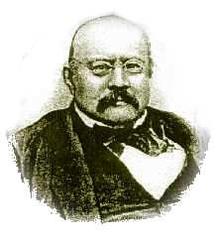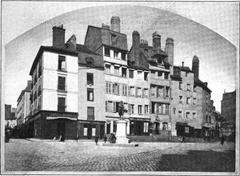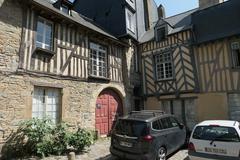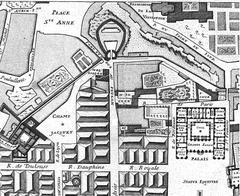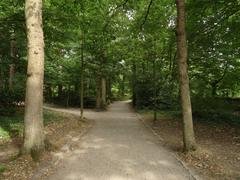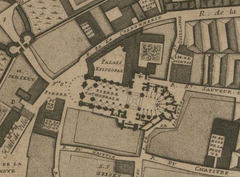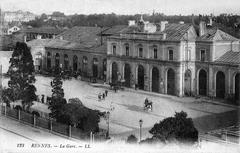
Paul Banéat Rennes Visiting Hours, Tickets, and Historical Site Guide
Date: 04/07/2025
Introduction to Paul Banéat and His Legacy in Rennes
Rennes, the vibrant capital of Brittany, is steeped in centuries of history—and much of what we know and see today is thanks to the tireless work of Paul Banéat (1856–1942). As a pioneering historian, archivist, and conservator, Banéat’s research, publications, and stewardship of Rennes’ historical institutions have preserved the city’s architectural and cultural heritage for future generations.
Banéat’s meticulous documentation of Rennes’ streets, monuments, and traditions not only enriched the collections of the Musée Archéologique de Rennes but also fostered a deep appreciation for Breton identity. His influence is visible throughout the city, from the preserved medieval streets to the local archives, and in the very names of streets and institutions that honor his legacy.
This guide provides comprehensive, practical information for visitors seeking to explore Banéat’s legacy in Rennes. You’ll find details on visiting hours, ticketing, accessibility, key historical sites, suggested itineraries, and resources to enrich your experience. Whether you’re a historian, a cultural traveler, or a curious explorer, this guide will help you discover Rennes through the lens of its greatest chronicler.
For official updates and current information, consult the Musée Archéologique de Rennes and the Rennes Tourism Office.
Table of Contents
- Introduction to Paul Banéat and His Legacy
- Musée Archéologique de Rennes
- Paul Banéat’s Broader Legacy in Rennes
- Practical Visitor Information
- Tips for Visitors and Accessibility
- Frequently Asked Questions (FAQ)
- Plan Your Visit and Stay Connected
- References and Further Reading
Musée Archéologique de Rennes
Visiting Hours and Tickets
-
Opening Hours:
Tuesday to Sunday: 10:00 AM – 6:00 PM
Closed Mondays and public holidays -
Ticket Prices:
- General admission: €6
- Reduced (students, seniors): €4
- Free: under 18s and Rennes residents
- Group bookings and guided tours by appointment
-
Accessibility:
The museum is wheelchair accessible and offers assistance for visitors with disabilities
(Musée Archéologique de Rennes Official Website)
Getting There
Centrally located in Rennes, the museum is easily accessible:
- Metro: Charles de Gaulle station (5-minute walk)
- Bus: Several city lines stop nearby
- Car: Public parking lots available; limited street parking
Highlights of the Collection
The museum’s collections reflect Banéat’s dedication:
- Prehistoric tools and artifacts from Brittany’s earliest inhabitants
- Gallo-Roman relics illustrating the region’s integration into the Roman Empire
- Medieval ceramics, weapons, and architectural fragments
- Rare manuscripts, many curated by Banéat himself
The exhibitions are designed with detailed documentation and contextual interpretation, in line with Banéat’s scholarly approach.
Guided Tours and Special Events
- Guided Tours:
Available in French and English (advance booking recommended) - Special Events:
Temporary exhibitions, lectures, and workshops are held regularly. Check the official website or the Rennes Tourism Office for current programming.
Paul Banéat’s Broader Legacy in Rennes
Key Historical Sites
Musée de Bretagne
Located at Les Champs Libres, the Musée de Bretagne is the primary institution for exploring Banéat’s archival legacy. The museum showcases his manuscripts, maps, and research notes, and often hosts exhibitions and educational programs inspired by his work.
- Hours: Tuesday to Sunday (extended evenings on Thursdays)
- Admission: €6 (adults), free on the first Sunday of each month
- Access: Near Rennes train station
Historic Center of Rennes
Banéat’s descriptions of medieval streets, timber-framed houses, and public squares remain foundational for walking tours and historic preservation. Guided or self-guided tours of the old quarter—especially around Place Sainte-Anne, Place des Lices, and Rue Saint-Michel—highlight the city’s unique character, much of which owes its survival to Banéat’s advocacy (The Good Life France).
Archives Départementales d’Ille-et-Vilaine
The Archives Départementales d’Ille-et-Vilaine house much of Banéat’s research material, including original manuscripts and correspondence. Open to the public, the archives are a valuable resource for scholars and visitors interested in Banéat’s methods and discoveries.
- Hours: Monday to Friday, advance booking recommended
Heritage Preservation and Cultural Identity
Banéat’s exhaustive cataloging enabled the classification of many buildings as Monuments Historiques, ensuring their protection. His influence extends to rural Brittany, where he documented churches, chapels, and traditional farmhouses.
Banéat also wrote extensively about Breton language and customs, helping to preserve intangible cultural heritage. Today, Rennes’ museums, festivals, and academic institutions continue to draw on his work to celebrate and maintain Breton identity (Persee).
Practical Visitor Information
Location and Access
Cimetière du Nord and Rue Paul Banéat
-
Cimetière du Nord:
- Address: Section 5, Rang 12, Tombe 29, Rennes
- Hours: Open from early morning until dusk (official information)
- Entry: Free
- Accessibility: Wheelchair-accessible paths; consult the interactive map for details
-
Rue Paul Banéat:
- Connects Boulevard Raymond Poincaré and Boulevard de Vitré
- Served by multiple bus lines, near Parc de Maurepas (wiki-rennes.fr)
Banéat’s Publications and Research
Banéat’s seminal works, including Le Vieux Rennes and Le département d’Ille-et-Vilaine. Histoire, archéologie, monuments, are available in local libraries such as the Bibliothèque de l’Université Rennes 2 (bibnum.univ-rennes2.fr) and sometimes in bookshops or digital collections (CPHR).
Guided and Self-Guided Tours
- Virtual Tours:
The city offers virtual tours of the Cimetière du Nord. - Walking Tours:
The Rennes Tourist Office provides themed tours referencing Banéat’s research. - Self-Guided Exploration:
Use Banéat’s publications alongside city maps for a “then and now” experience in the historic center.
Tips for Visitors and Accessibility
- Best Seasons to Visit: Spring and early autumn offer mild weather and fewer crowds.
- What to Bring: Comfortable shoes (cobblestones and uneven paths), a guidebook or Banéat’s works, and a camera for discreet photography.
- Local Etiquette: Maintain a respectful demeanor in cemeteries and historical sites.
- Accessibility: Museums and archives are wheelchair accessible; the historic center has some cobbled streets.
Frequently Asked Questions (FAQ)
Q: What are the visiting hours and ticket prices for the Musée Archéologique de Rennes?
A: Open Tuesday to Sunday, 10:00 AM–6:00 PM. General admission €6; reduced €4; free for children under 18 and Rennes residents.
Q: Can I visit Paul Banéat’s grave?
A: Yes, the Cimetière du Nord is open daily (see official hours); entry is free.
Q: Are guided tours available in English?
A: Yes, by advance request at the museum and through the Rennes Tourist Office.
Q: Where can I find Banéat’s works?
A: In local libraries (notably Bibliothèque de l’Université Rennes 2), archives, and sometimes as digital editions online.
Q: How accessible are Banéat-related sites?
A: Museums and archives are accessible; cemetery paths are generally accessible but older sections may be uneven.
Plan Your Visit and Stay Connected
-
For the latest information, consult these resources:
-
Download the Audiala app for audio guides, interactive maps, and up-to-date event information.
-
Follow @RennesCulture and @Audiala on social media for news, tips, and cultural updates.
References and Further Reading
- Visiting the Musée Archéologique de Rennes: Hours, Tickets, and What to See, 2025, Rennes.fr (Musée Archéologique de Rennes)
- Exploring Paul Banéat’s Legacy: Key Historical Sites and Visitor Information in Rennes, Brittany, 2025, Musée de Bretagne (Musée de Bretagne)
- Discover Paul Banéat in Rennes: Visiting Hours, Tickets & Historical Sites Guide, 2025, Tourisme Rennes (Tourisme Rennes)
- Visiting Paul Banéat’s Legacy in Rennes: Hours, Access, and Historical Insights, 2025, Cimetière du Nord Rennes (Cimetière du Nord - Paul Banéat)
- Wikipedia: Paul Banéat (Wikipedia)
- Persee: Paul Banéat Publications and Legacy (Persee)
- The Good Life France: Rennes Travel Guide (The Good Life France)
By exploring Rennes with Paul Banéat as your guide—through museums, archives, historical sites, and walking tours—you’ll gain a deep appreciation of the city’s layered past and living heritage. Make use of digital resources and official tourism services to enhance your experience, and honor the legacy of one of France’s great regional historians.



